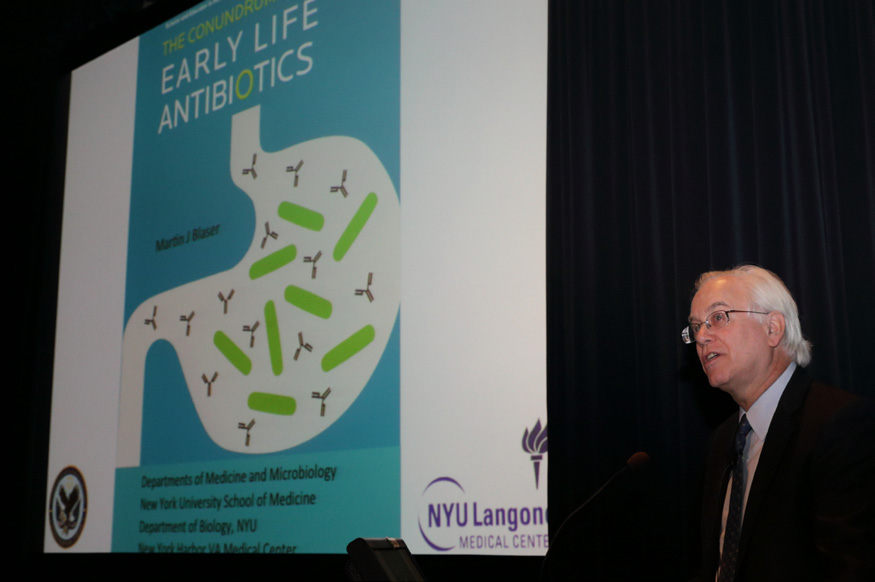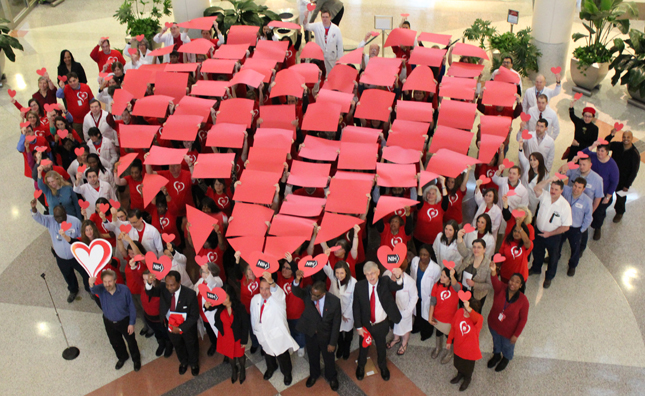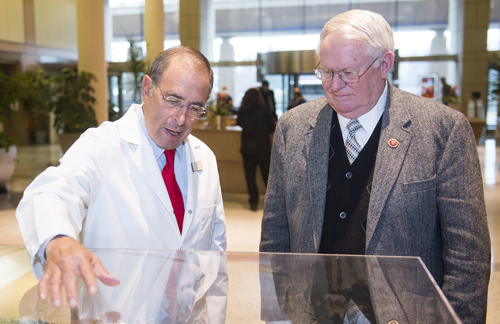

March 2014
IN THIS ISSUE:
![]()
- Nutrition study examines how certain fats affect hunger, appetite
- 'Get heart healthy' NIH says
- Nurse Consultant praised for workplace safety
- Rare Disease Day focuses on research innovations
- Pediatric patient beats cancer, lives an athletic life with family
- Legislators welcomed to Clinical Center, briefed on NIH research advances
- NY doctor receives distinguished clinical research scholar award
- Upcoming Events
Print this Issue ![]() (609 KB)
(609 KB)
ABOUT CC NEWS:
![]()
Published monthly by the Office of Communications and Media Relations. News, article ideas, calendar events, letters, and photographs are welcome. Submissions may be edited.
Clinical Center News
National Institutes of Health
Building 10, 10 Center Drive
Room 6C-420,
Bethesda, MD 20892-1504
Tel: 301-594-5789
Fax: 301-402-4984
Molly.hooven@nih.gov
QUICK LINKS:
![]()
Nutrition study examines how certain fats affect hunger, appetite
 |
A typical breakfast in the study. |
National Institutes of Health researchers are investigating how essential fatty acids affect hunger, craving and appetite in overweight women.
With obesity rates on the rise in the U.S., understanding how diet affects hunger, metabolism and body composition is important, according to Dr. Amber Courville, metabolic clinical research dietitian with the Clinical Center's Nutrition Department.
Researchers know essential fatty acids should be included in a healthy diet, but they don't know the optimal amounts. That is the focus of an NIH Clinical Center dietary trial being conducted in partnership the National Institute on Alcohol Abuse and Alcoholism (NIAAA).
"We are studying how these dietary fats affect hunger and body weight by altering signaling molecules known as endocannabinoids," said Courville, lead associate investigator in the trial.
Endocannabinoids, which are made from the fats people eat, are increasingly linked to impaired satiety responses for foods and substances of abuse, according to Dr. Joseph Hibbeln, psychiatrist and chief of the NIAAA Section on Nutritional Neurosciences.
Hibbeln's previous work with mice showed that dietary fats could prevent obesity by altering endocannabinoids.
"The demonstration that endocannabinoids and related molecules are regulated by diet has implications beyond obesity," said Dr. Christopher Ramsden, NIAAA clinical investigator and the principal investigator in the trial. "We are very interested in the role these molecules play in alcoholism, substance abuse and chronic pain."
This clinical trial includes a three-month feeding study.
"We choose to focus on women, since men and women metabolize fat differently. Changes would be more clearly detected in women making it easier to see results," Courville said.
Currently, almost 30 women are participating in the trial, which has been ongoing since December 2011. The goal is to study a total of 84 pre-menopausal women.
Another requirement for participants was a body mass index of 25 to 35, women who are overweight or slightly obese.
"We're working with overweight participants so any weight loss won't negatively affect them," Courville explained.
Dietitians play a critical role in this project. It took Courville a year to develop diets with exact amounts of each fatty acid of interest that also meet the dietary needs to maintain a healthy adult. A day might include pancakes for breakfast, a sandwich for lunch and shrimp scampi for dinner.
"Everything the subjects eat for three months is made and weighed in our kitchen," Courville said.Participants maintain a daily food log to annotate provided foods they did not eat and any additional food they ate in a day.
Two health technicians or the dietitians meet with participants daily.
"Participants come here every weekday to pick up their meals, picking up all weekend meals on Friday afternoons. We are the only place that can do a feeding study of this magnitude," Courville said.
Measurements are conducted at the beginning, one-month mark and conclusion of the study. Participants fill out a questionnaire about hunger; have blood drawn for analysis; under-go dual x-ray absorptiometry for body composition and body fat; and complete a meal test where participants are allowed to eat until they are full.
Comparing the initial meal test and questionnaire results to the final shows actual physical proof of changes in satiety and appetite, Courville said.
'Get heart healthy' NIH says
Volunteers filled the Clinical Center atrium Feb. 3 and created a geometric heart to celebrate American Heart Month. The National Heart, Lung, and Blood Institute event raised awareness of heart disease, which is the number one killer of both men and women in America.
At the event Dr. Francis S. Collins, NIH director, said "Deaths from heart attack and stroke have dropped by more than 70 percent over the course of the last few decades, and that's based upon work done by NIH, across the country, and some here in this facility."
"We've been in this business since the very beginning and some wonderful accomplishments have happened here," said Dr. John I. Gallin, NIH Clinical Center director. "The first heart valve, the mitral heart valve, was put in a patient in this building by one of the very first woman cardiac surgeons, Nina Braunwald."
The crowd shouted "Happy National Wear Red Day from our hearts to yours" and "Get heart healthy" for a promotional video. View the video [disclaimer] and view more information on heart disease.
Nurse Consultant praised for workplace safety
 |
Mary Fleury and Helen Mayberry. |
The NIH 'Mission First, Safety Always' award was presented to CC Nurse Consultant Helen Mayberry in January 2014 for her leadership, innovation and involvement in promoting safety in the workplace. Eight other NIH staff members from across the campus were also recognized.
According to Mary Fleury and Megan Mikula, nurse educators who nominated Mayberry, "Helen has played a key role in the implementation and ongoing support of barcoding for enhanced safety in patient specimen collection and blood product transfusion verification in the CC. Helen focuses on safety in every aspect of clinical practice. Her collaborative efforts lead to creative problem solving to remove barriers to compliance, and to promote staff understanding of safe practices."
The award was presented by the Office of Research Services Division of Occupational Health and Safety.
Rare Disease Day focuses on research innovations
Leaders from across the NIH, industry, media and government came together at the Clinical Center on Rare Disease Day Feb. 28 to discuss a continued commitment to research and to recognize the daily impact rare diseases have on more than 25 million Americans.
In the U.S. a rare disease is generally considered to be a disease that affects fewer than 200,000 people. The NIH Office of Rare Diseases Research (ORDR) in the National Center for Advancing Translational Sciences (NCATS), which helped organize the daylong symposium, works to raise awareness of the more than 6,800 rare diseases, strengthen the voice of patients and advocacy groups and bring stakeholders closer together.
Dr. David J. Eckstein, senior health scientist administrator with ORDR, said the Clinical Center provides a place where a large number of patients with uncommon illnesses can be seen and studied and the intramural labs help foster the research.
"We hope the focus on Rare Disease Day will inform the NIH community of opportunities to participate in ongoing research by intramural investigators and the research supported by the extramural programs at academic centers in the U.S. and around the world," said Eckstein. "We want to tell extramural staff about the importance of nurturing academic research in these understudied areas by supporting scientific conferences and providing resources that facilitate collaboration."
Speakers expanded the conversation on rare diseases and talked about rare genetic heart conditions; a cyclodextrin trial; a brain-directed adeno-associated virus gene therapy for neurometabolic rare diseases; a recurrent mutation causing ablepharon-macrostomia syndrome; development of effective therapies for neurofibromatosis type 1 related tumors; and targeting the metabolic basis of kidney cancer.
In addition to highlighting the work that remains ahead, participants celebrated new projects and breakthroughs. Dr. Anastasia Wise, program director with the National Human Genome Research Institute (NHGRI), presented a growing initiative that aims to improve the level of diagnosis and care for patients with undiagnosed diseases.
"Building on the success of the NIH Undiagnosed Diseases Program (UDP), the Common Fund Undiagnosed Diseases Network (UDN) is being established across the country to diagnose both rare and new diseases," said Wise. "One of the comments we heard from patients was that sometimes it can be hard for them to get to the NIH. The UDN will help address this concern by establishing five to seven additional clinical sites across the U.S."
In reflecting on NIH's continued commitment towards research on rare illnesses, Wise also emphasized how even the smallest discoveries can mean so much for the patients.
"We hear a lot from the patients that are undiagnosed that even if we are just able to tell them something about their condition and that doesn't necessarily help with the treatment it helps them to have an end to the diagnostic odyssey," said Wise.
Eckstein recalled a significant breakthrough made last year by group supported by the NIH [disclaimer] on a rare disorder that results in a birthmark and nervous system problems.
"[They] found the genetic cause for Sturge-Weber syndrome and port wine birthmarks. It provided a great relief to the parents that they didn't pass on something that caused this," said Eckstein. "They were happy that there could potentially be some therapeutics developed now that they know what the cause is. It showed the real value to the partnerships and programs that our office has developed."
Throughout the day, NIH experts also described the Eunice Kennedy Shriver National Institute of Child Health and Human Development/NHGRI Newborn Sequencing In Genomic medicine and public HealTh (NSIGHT) program; Clinical Center sequencing program; using individual, parental and population information to improve sequence alignment; UDP information system; and next steps for newly diagnosed.
Several organizations including the Pharmaceutical Research Manufacturers of America, Analysis Group, Inc., the National Organization for Rare Disorders, Uplifting Athletes, the Global Genes Project and the Genetic Alliance provided their outlook on rare diseases.
"I think people are more aware of the diversity of disease and the challenges we have ahead of us in treating it," said James C. O'Leary, chief innovation officer at the Genetic Alliance, an organization that promotes optimum health care for people with genetic disorders. "We need a culture of participation from individuals, advocates and researchers in order to truly make a dent."
Throughout the symposium, posters and exhibits were on display and CC tours were provided. Activities were supported by ORDR, the CC, other Institutes and Centers; the Food and Drug Administration's Office of Orphan Product Development; other Federal Government agencies; the National Organization for Rare Disorders [disclaimer]; and the Genetic Alliance [disclaimer].
View more information on the daylong event.
![]()
Pediatric patient beats cancer, lives an athletic life with family
 |
Daniel Immesoete, pictured with his wife Leanne and their son and daughter, enjoys an active lifestyle. |
Daniel Immesoete came to the NIH Clinical Center as a pediatric cancer patient. After nearly two months of chemotherapy and three years of check-ups, he hasn't had to return for more than 15 years.
"I first came to NIH in 1978 at 14-years-old, following a diagnosis of osteogenic sarcoma," Immesoete said. "The disease started in the bone above the right knee and had spread throughout the soft tissue. The amputation [of my leg] was done at Mayo Clinic in February of 1978."
Just a month later, a tumor was found in the lung, which is the typical progression of osteogenic sarcoma if it is to recur.
"My dad was a physician, and he suspected the possibility of cancer initially. He felt the best course was to go to NIH. [There] the diagnosis was confirmed, then I had bi-lateral lung surgery, followed by eight weeks [of] intensive chemotherapy in Building 10."
Even as a pediatric patient, Immesoete can still recall how big a difference the staff made on his stay. "I remember the people very well because they made a big impression on me. They were all 100 percent focused on learning and developing the best protocols," he said. "I believe these physicians felt like they were working in a period where they could really contribute to new understanding for cancer treatment. When I look at today's protocols, they seem to be derived from the work these guys did. I had some amazing oncology nurses as well, who were highly trained experts in this field."
Immesoete is now a dedicated athlete who likes to swim, bike, run and do triathlons. He lives with his wife and two children in Illinois and is a senior engineer at a company that provides a platform for mobile health devices and applications.
"I basically just live a normal life coaching and chasing [my kids] around to various sports events. There's no question that I'm alive due to my experience at the NIH."
Read more reflections at our 60th anniversary website.
Legislators welcomed to Clinical Center, briefed on NIH research advances
| ||||||
|
| |||||
NY doctor receives distinguished clinical research scholar award
Lectures on overuse of childhood antibiotics
 |
Dr. Martin J. Blaser discussed the human microbiome and the pressures that are affecting microbiome composition. |
Dr. Martin J. Blaser, director of the Human Microbiome Program at New York University Langone Medical Center, was honored as the second recipient of the NIH Clinical Center's 2014 Distinguished Clinical Research Scholar and Educator in Residence.
The award is given to an established clinical investigator with outstanding scientific credentials who has also demonstrated a career devoted to teaching and mentoring.
Blaser, who is also the Muriel G. and George W. Singer professor of Translational Medicine and a professor of microbiology, visited the Clinical Center and discussed how the use of antibiotics in young children may cause long-term health problems in his Contemporary Clinical Medicine: Great Teachers lecture in Lipsett Amphitheater Feb. 12.
Everyone has trillions of microbes within their body, which are single-celled organism that are bacteria, viruses and/or yeasts. These microbes make up what's called the human microbiota. While a few can be harmful, most microbes in our bodies are beneficial and help us digest food, produce vitamins or protect our immune system from threats.
Around the 1900s, the most common microbe in the stomach was Helicobacter pylori. Today, fewer than 6 percent of children in the U.S., Sweden and Germany have it and those who do are at increased risk of developing stomach ulcers and adenocarcinoma, the most common form of stomach cancer.
But, as Helicobacter pylori has disappeared in the U.S., the incidence of acid reflux, asthma, hay fever and skin allergies has increased.
It's possible that when a child takes an antibiotic to treat, for example, an ear or respiratory infection, beneficial bacteria, such as Helicobacter pylori may also be harmed.
"I'm wondering if there's collateral damage to the microbiome that effects the development of metabolic and neurological pathways," Blaser said.
Blaser has also examined how our stomachs act differently after a course of antibiotics. As evidence, he cited one of his lab's animal studies. A student in his lab gave mice four doses of antibiotics similar to what children receive for an ear infection.
Even though their diets remain unchanged, the mice gained weight. The evidence suggests that after four doses, the mice's body composition permanently changed.
Although the long-term physiological changes in humans are unclear, Blaser thinks that Americans can reduce their dependence on antibiotics. In Sweden, antibiotic usage rates are much lower compared to the usage rates in the U.S.
"My guess is that we can markedly reduce antibiotic usage in this country without harmful effects on human health."
Upcoming Events
Lectures will be streamed and archived
Contemporary Clinical Medicine: Great Teachers Lecture
Cancer Control in the 21st Century
March 12, 2014; Noon - 1:00 p.m.
Lipsett Amphitheater
Presented by Otis W. Brawley, M.D., FACP, Emory University and American Cancer Society.
NIH Director's Wednesday Afternoon Lecture Series
The Annual Florence Mahoney Lecture: Epigenetic Regulation of Senescence and Aging
March 12, 2014; 3:00 p.m. - 4:00 p.m.
Masur Auditorium
Presented by Shelley Berger, Perelman School of Medicine at the University of Pennsylvania.
Clinical Center Grand Rounds Lecture
Clinicopathologic Grand Rounds: Clinical Cases from the NIH Clinical Center; Allogeneic Hematopoietic Stem Cell Transplant for Dock8 Deficiency: Past, Present and Future
March 19, 2014; Noon - 1:00 p.m.
Lipsett Amphitheater
Presented by Alexandra Freeman, M.D., NIAID and Dennis Hickstein, M.D., NCI.
NIH Director's Wednesday Afternoon Lecture Series
The Annual Margaret Pittman Lecture: Did You Remember to Take Out the Trash?
Your Cells Sure did!
March 19, 2014; 3:00 p.m. - 4:00 p.m.
Masur Auditorium
Presented by Ana Maria Cuervo, Albert Einstein College of Medicine.
Clinical Center Grand Rounds Lecture
AIDS in 2014-What We Know, What We Think We Know, and What We Don't Know
March 26, 2014; Noon - 1:00 p.m.
Lipsett Amphitheater
Presented by Henry Masur, M.D., CC and H. Clifford Lane, M.D., NIAID.
NIH Director's Wednesday Afternoon Lecture Series
How Telomeres Solve the End-protection Problem
March 26, 2014; 3:00 p.m. - 4:00 p.m.
Masur Auditorium
Presented by Titia de Lange, The Rockefeller University.
NIH Director's Wednesday Afternoon Lecture Series
Mitochondria Interest Group Symposium; Transformational Medicine in the Mitochondrial Age
April 2, 2014; 8:00 a.m. 4:00 p.m.
Masur Auditorium
Presented by Douglas Wallace, Perelman School of Medicine at the University of Pennsylvania. Symposium will feature two presentations chosen from the poster abstracts. Registration and more information.
NOTE: PDF documents require the free Adobe Reader.
 The information on this page is archived and provided for reference purposes only.
The information on this page is archived and provided for reference purposes only.


